Tell us about your approach to photography. How it all started? What are your memories of your first shots?
Jasper Léonard (JL): My first memories of photography are definitely my family photo book. According tot this exquisite document, my first picture was one of a rose standing grimly in a backyard in Antwerp. I remember my mother telling me as a child: «The best moments in life will not be captured in a picture, so try to remember those moments». The real passion for photography grew when I was studying advertising. I never cared much about school and I had no clue where my education was heading. My teacher of ‘digital photography’ gave us the assignment to make a series about ‘depth, repetition, contrast, diagonals…’ At that point in time my world suddenly changed. As I continued my studies, I started documenting everything.
How did your research evolve with respect to those early days?
JL: When I started my dissertation on visual arts at Sint lucas, I did a ton of research and found a lot of inspiring work from the 20’s and 30’s. Back then photography was a ‘new canvas’ for people to capture parts of reality. For some reason, the loss of faith in humanity (during the interbellum) and the search for new horizons are very inspiring to me.
Tell us about your educational path. What are the best memories of your studies? What was your relationship with photography at that time?
JL: I started my studies as a 'land surveyor’. A friend of mine convinced me to try Sint Lucas… and that’s sort of how I rolled into photography. I loved the creative aspect of ‘advertising’. Basically it means coming up with new and better solutions for problems. I still use this knowledge every day… After I finished my studies in ‘advertising’ with a photographic dissertation I did one extra year of photography. It felt liberating to focus only on photography, and to see other passionate people dealing with the medium.
What were the courses that you were passionate about and which have remained meaningful for you?
JL: One of the courses we got was a class ‘Drawing on location’ and ‘drawing nude models.’ I loved how drawing helps you focus, and also forces you to make a lot of aesthetical choices. Because of my lack of drawing skills, I was one of the worst illustrators of my class, but I loved it nevertheless. I remember one of the most inspiring teachers (Andreas Vanpoucke) telling us one spring: «these two weeks, are the only weeks in the entire year when the leafs on the plants and trees display this many shades of green». It’s mostly these type of small things that I will never forget. And every spring when the green colours explode again, there is a huge smile on my face.
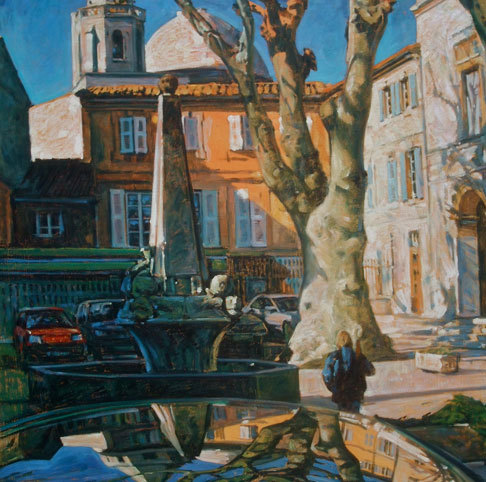
© Andreas Vanpoucke, Saint Remy
Any professor or teacher that has allowed you to better understand your work?
JL: During my dissertation I started doing research into how reality can be ‘captured’ by photography, this research led me to understand how the eye works, but also how images are formed in our brains. Since my approach was rather technical, I searched for teachers who followed this train of thought. This is how I ended up meeting withWerner Van Dermeersch. He is actually an architect and gave me a lot of support, feedback and helped me to understand a lot of the technical aspects of photography as well as how vision works.
What do you think about photography in the era of digital and social networking?
JL: I think the digital era in photography really is an epic time, it enables you to experiment so much more. I currently use both digital and analogue techniques for certain projects as long as it fits the concept. As a full time photo- and videographer I get a lot of work and customers through Social media.
About your work now. How would you describe your personal research in general?
JL: For my dissertation at Sint Lucas, I started a research project on how photography is a reflection of reality. I first researched what people are using photography for and how they portrait themselves. Eventually I found a strange ‘off beat’ way to contemplate my own visual language.
I felt the need to alter camera - lenses. As photography these days is a ‘package of marketing’ you buy. The way digital images are created is a well-programmed and well -designed way of making people colour in between the lines.
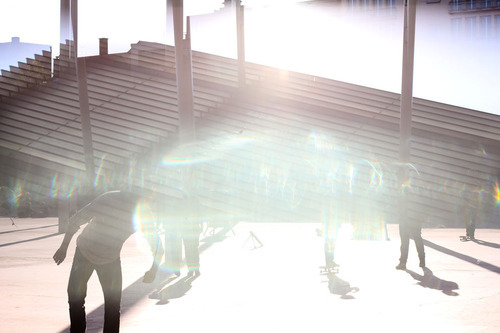
© Jasper Léonard. Digital dslr picture using an attached mirror lens
I started off with making lens attachments for cameras and lenses. It started with a piece of mirror that I mounted in front of my lens. This is how I created images in one location, with parts of the visual field mixed in one photograph.. This was only a starting point, in total I created around eight working attachments or lenses for cameras. One of them was just a big spoon, which reflects a ‘fish eye’ image of the photographer and camera. This lens is basically a “selfie machine”.
Do you have any preferences in terms of cameras and format?
JL: The last years I kept altering lenses in my personal work. I use digital DSLR’s for commercial projects and some personal projects, although I feel the need to de-associate myself from post production. For me the creation of an image is something that has to happen in the moment, not the next day in Photoshop. I try to keep my work ‘in camera’. This forces me to make all the decisions on location. Although I was schooled in digital photography I became fascinated with analogue camera techniques. What started of as a fascination for old camera techniques ended up leading me to a whole new body of work. From 2011 on, I started doing research into ‘multiple exposures’. This project, I have to admit, got out of hand. At first, I used 120 film camera’s like a ’Zeiss Ikon nettar’ from the 20’s. Eventually I found my way to a medium format Bronica with better lens quality. In search of a wide angle lens, I stumbled upon a ‘view camera‘ (cambo) which I use for my latest work; an analogue large format series. The reason why I work with this huge camera from the 50’s is just a logical consequence of my work. I can use many different film holders, resulting in combinations of light from different places and time. I started making sketches for most of my pictures and I am constantly on the hunt for inspiring places and the right light conditions. Old habits die hard so I even started attaching different lenses to this camera, creating circular compositions in some of my works.
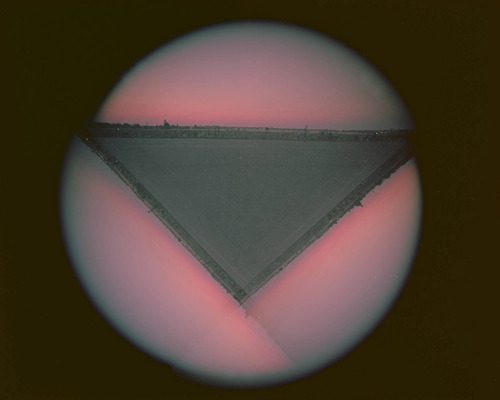
© Jasper Léonard. Kodak portra iso 160. Triple exposed with a rotation of the negative. Using a medium format lens. Berlin 2014
Tell us about your latest project
JL: My latest series is called ‘Fractal horizons’. It consists of a multiple exposure landscape series which could be called psychedelic. It is my first analogue series and first large format project. In the exhibition I exposed small light boxes containing the original ‘dia positives’ of some of my works. With a size from 12 to 10cm they appear as bright beacons of light.
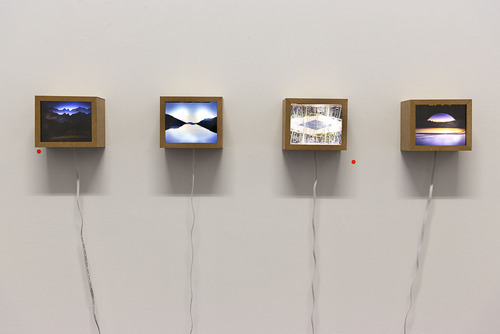
© Jasper Léonard. Expo view of 4 light boxes with original dia positives
I hoped people would find out for themselves that the series was created without photoshop or post processing, unfortunately my work often appears too abstract to be seen as ‘analogue’.
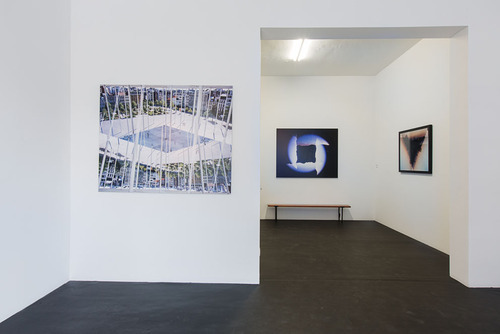
© Jasper Léonard. Expo view fractal horizons
In this ‘digital post processing era’ my work appears to be out dated as people take my work for “digital photo manipulations”. Nevertheless I do feel this is the perfect time for work to question where photography is heading as opposed to where it comes from.
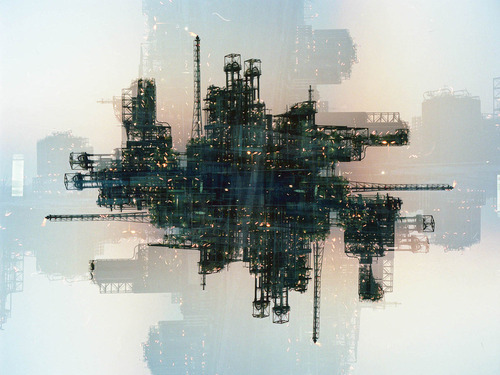
© Jasper Léonard. Four times exposed view on a chemical plant. Kodak portra iso 400. Bronica etr
As I do a lot of ‘time lapse video work’, part of my inspiration comes from time and the way light changes during transitions in time.

© Jasper Léonard. Three times exposed negative shifting the back of the camera. Fuji 100F Cambo + Schneider 90mm
Using these old camera techniques allows me to slow down and take an entire evening (or even more.) for just one image. This evolution in my work is still evolving and I’m quite excited to see where it’s headed.
Is there any contemporary artist or photographer, even if young and emerging, that influenced you in some way?
JL: Although my personal work is rather off beat, I follow a lot of expo’s and exhibitions on both photography and arts in general. I have a lot of respect for artists like Jef Beirinckx who can make reality look like a playground. I love the way Richard Mosse uses his infrared film to make people think about the Congo and the impact of this conflict on human lives. At Breda Photo this year I loved the work (and book) of Alexander Gronsky about the borders of cities. As well as Andrej Glusgold’s landscape series with the reference to the romantic painter Caspar David Friedrich.
Three books of photography that you recommend?
JL: 'Pastoral / Moscow suburbs' by Alexander Gronsky;
'Belgicum' by Stephan Vanfleteren, a classic;
'Pierdom' by Simon Roberts.
Is there any show you’ve seen recently that you find inspiring?
JL: Sure lot’s of them, Richard Mosse was my latest favourite.
Projects that you are working on now and plans for the future?
JL: As my large format project slowly crawls further on a steady but slow pace there might be another expo in 2015 related to it . I’m currently fusing multiple locations with different techniques.
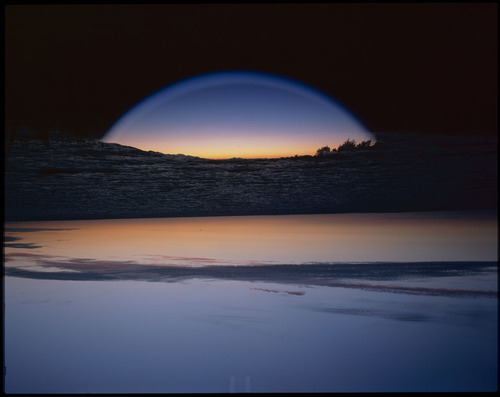
© Jasper Léonard. Fuji 100F with cambo. Fusing the ocean in France and the mountains in spain
I’m also thinking about an expo about the ‘theaterplein’ in Antwerp, I find myself bound to return to this plaza many times a year, and I created a diverse body of work relating to it.
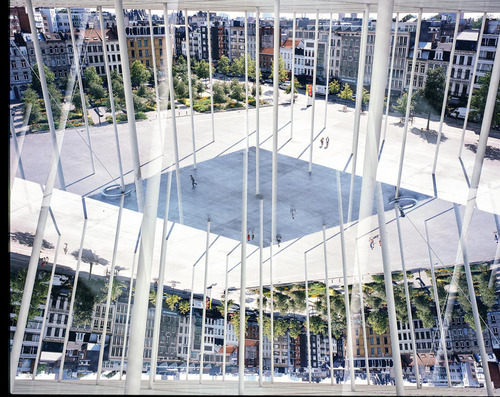
© Jasper Léoanard. uji provia 100F Double exposed turning the negative
I am also working on a photo book, with an analogue series that I created in the US. If the book finds it’s way to a publisher that is. This series is part of a research project created on a road trip in America.
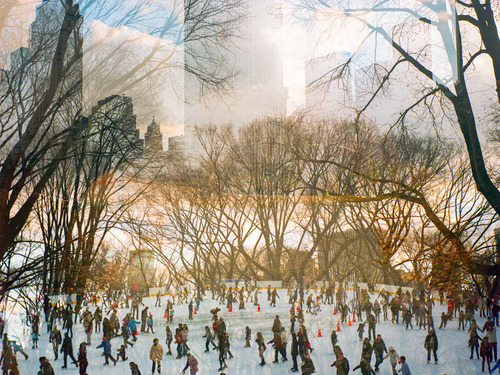
© Jasper Léonard. Zeiss ikon nettar with Kodak portra iso 400. Double exposed view in central park 2013
In 2016 there will be an exhibition featuring some of my works I produced in the context of ‘stadsfotograaf antwerpen’ (City photographers of Antwerp.)
---
LINKS
Jasper Léonard
Belgium
share this page
